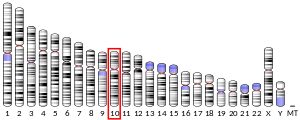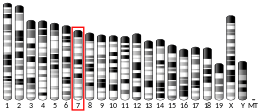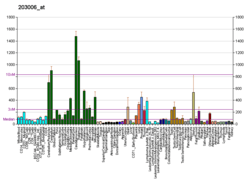INPP5A
Type I inositol-1,4,5-trisphosphate 5-phosphatase is an enzyme that in humans is encoded by the INPP5A gene.[5][6]
The protein encoded by this gene is a membrane-associated type I inositol 1,4,5-trisphosphate (InsP3) 5-phosphatase. InsP3 5-phosphatases hydrolyze Ins(1,4,5)P3, which mobilizes intracellular calcium and acts as a second messenger mediating cell responses to various stimulation.[6]
References
- GRCh38: Ensembl release 89: ENSG00000068383 - Ensembl, May 2017
- GRCm38: Ensembl release 89: ENSMUSG00000025477 - Ensembl, May 2017
- "Human PubMed Reference:". National Center for Biotechnology Information, U.S. National Library of Medicine.
- "Mouse PubMed Reference:". National Center for Biotechnology Information, U.S. National Library of Medicine.
- De Smedt F, Verjans B, Mailleux P, Erneux C (Jul 1994). "Cloning and expression of human brain type I inositol 1,4,5-trisphosphate 5-phosphatase. High levels of mRNA in cerebellar Purkinje cells". FEBS Lett. 347 (1): 69–72. doi:10.1016/0014-5793(94)00509-5. PMID 8013665.
- "Entrez Gene: INPP5A inositol polyphosphate-5-phosphatase, 40kDa".
Further reading
- Laxminarayan KM, Chan BK, Tetaz T, et al. (1994). "Characterization of a cDNA encoding the 43-kDa membrane-associated inositol-polyphosphate 5-phosphatase". J. Biol. Chem. 269 (25): 17305–10. PMID 8006039.
- Mitchell CA, Speed CJ, Nicholl J, Sutherland GR (1996). "Chromosomal mapping of the gene (INPP5A) encoding the 43-kDa membrane-associated inositol polyphosphate 5-phosphatase to 10q26.3 by fluorescence in situ hybridization". Genomics. 31 (1): 139–40. doi:10.1006/geno.1996.0023. PMID 8808294.
- Bonaldo MF, Lennon G, Soares MB (1997). "Normalization and subtraction: two approaches to facilitate gene discovery". Genome Res. 6 (9): 791–806. doi:10.1101/gr.6.9.791. PMID 8889548.
- Auethavekiat V, Abrams CS, Majerus PW (1997). "Phosphorylation of platelet pleckstrin activates inositol polyphosphate 5-phosphatase I." J. Biol. Chem. 272 (3): 1786–90. doi:10.1074/jbc.272.3.1786. PMID 8999861.
- Campbell JK, Gurung R, Romero S, et al. (1998). "Activation of the 43 kDa inositol polyphosphate 5-phosphatase by 14-3-3zeta". Biochemistry. 36 (49): 15363–70. doi:10.1021/bi9708085. PMID 9398266.
- Lee SH, Davison JA, Vidal SM, Belouchi A (2001). "Cloning, expression and chromosomal location of NKX6B TO 10Q26, a region frequently deleted in brain tumors". Mamm. Genome. 12 (2): 157–62. doi:10.1007/s003350010247. PMID 11210186.
- Strausberg RL, Feingold EA, Grouse LH, et al. (2003). "Generation and initial analysis of more than 15,000 full-length human and mouse cDNA sequences". Proc. Natl. Acad. Sci. U.S.A. 99 (26): 16899–903. doi:10.1073/pnas.242603899. PMC 139241. PMID 12477932.
- Hartmann TB, Thiel D, Dummer R, et al. (2004). "SEREX identification of new tumour-associated antigens in cutaneous T-cell lymphoma". Br. J. Dermatol. 150 (2): 252–8. doi:10.1111/j.1365-2133.2004.05651.x. PMID 14996095.
- Deloukas P, Earthrowl ME, Grafham DV, et al. (2004). "The DNA sequence and comparative analysis of human chromosome 10". Nature. 429 (6990): 375–81. doi:10.1038/nature02462. PMID 15164054.
- Gerhard DS, Wagner L, Feingold EA, et al. (2004). "The status, quality, and expansion of the NIH full-length cDNA project: the Mammalian Gene Collection (MGC)". Genome Res. 14 (10B): 2121–7. doi:10.1101/gr.2596504. PMC 528928. PMID 15489334.
This article is issued from Wikipedia. The text is licensed under Creative Commons - Attribution - Sharealike. Additional terms may apply for the media files.




